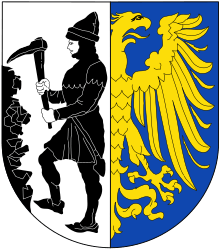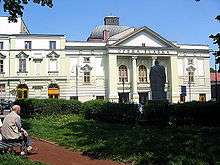Bytom
Bytom (Polish pronunciation: [ˈbɨtɔm] (![]()
Bytom | |
|---|---|
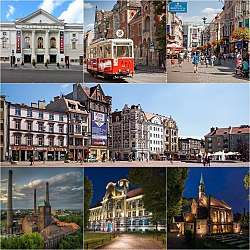 From top, left to right: Silesian Opera, Historic tram (in background Main Post Office), Dworcowa Street, Market square, Szombierki Heat Power Station, High school on Władysław Sikorski Square, The church of St. Margaret | |
 Flag | |
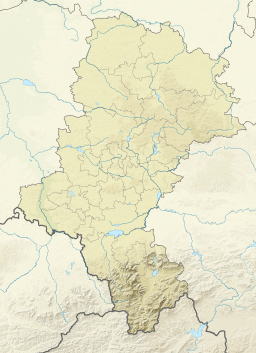 Bytom 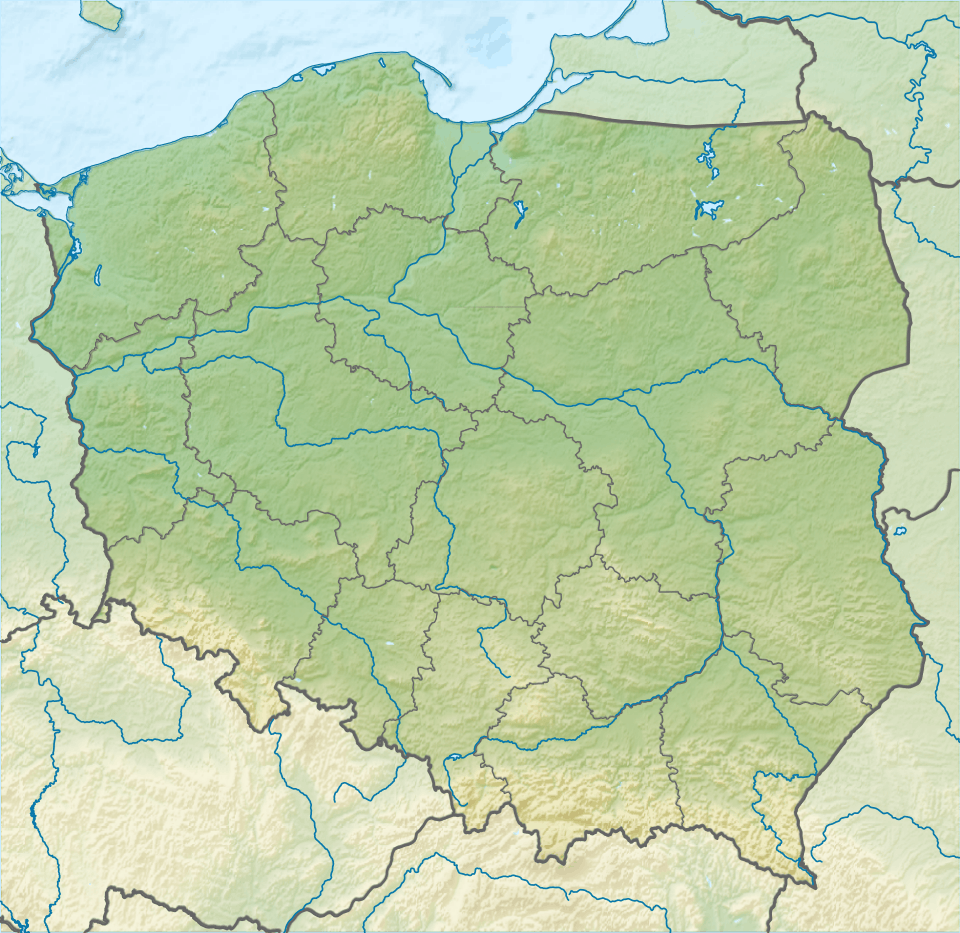 Bytom | |
| Coordinates: 50°20′54″N 18°54′56″E | |
| Country | Poland |
| Voivodeship | Silesian |
| County | city county |
| Established | 12th century |
| Town rights | 1254 |
| Government | |
| • Mayor | Mariusz Wołosz (KO) |
| Area | |
| • City | 69,44 km2 (2,681 sq mi) |
| Highest elevation | 330 m (1,080 ft) |
| Lowest elevation | 249 m (817 ft) |
| Population (31 December 2019) | |
| • City | 165,263 |
| • Density | 2,442/km2 (6,320/sq mi) |
| • Urban | 2,710,397 |
| • Metro | 5,294,000 |
| Time zone | UTC+1 (CET) |
| • Summer (DST) | UTC+2 (CEST) |
| Postal code | 41-900–41-936 |
| Area code(s) | +48 32 |
| Car plates | SY |
| Website | www |
It is one of the oldest cities in the Upper Silesia, and the former seat of the Piast dukes of the Duchy of Bytom. Until 1532, it was in the hands of the Silesian Piasts, then it belonged to the Hohenzollern dynasty. After 1623 it was a state country in the hands of the Donnersmarck family. From 1742–1945 the town was within the borders of Prussia and Germany, and played an important role as an economic and administrative centre of the local industrial region. Until the outbreak of World War II, it was the main centre of national, social, cultural and publishing organisations fighting to preserve Polish identity in Upper Silesia.
During Kristallnacht in 1938, Nazi Germans burned down the Bytom Synagogue. In 1942, the Beuthen Jewish community was liquidated and its members were the first transport to be sent to Auschwitz concentration camp.
After the war, decades of the Polish People's Republic were characterized by a constant emphasis on the development of heavy industry, which deeply polluted and degraded Bytom. After 1989, the city experienced a socio-economic decline. The city is blighted with derelict, dilapidated buildings which are ubiquitous. The population has been in rapid decline since 1999 leading to a number of locals describing the city as a ghost town. Poverty remains rife in Bytom. However, it is an important place in the cultural, entertainment, and industrial map of the region.
Geology
The bedrock of the Upland of Miechowice consists primarily of sandstones and slates. The rocks are punctuated with abundant natural resources of coal and iron ore from the Carboniferous period. In the north part of the upland, in the Bytom basin lays the broad range of the triassic rocks, from sandstones to limestones, with rich ore, zinc and lead reserves. The upper layer is composed of clay, sand and gravel.
Coat of arms
One half of the coat of arms of Bytom depicts a miner mining coal, while the other half presents a yellow eagle on the blue field – the symbol of Upper Silesia.
History
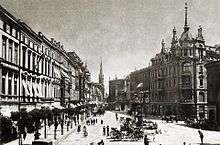
Bytom is one of the oldest cities of Upper Silesia, originally recorded as Bitom in 1136, when it was part of the Medieval Kingdom of Poland. Archaeological discoveries have shown that there was a fortified settlement (a gród) here, probably founded by the Polish King Bolesław I the Brave in the early 11th century.[2]
After the fragmentation of Poland in 1138, Bytom became part of the Seniorate Province, as it was still considered part of historic Lesser Poland. In 1177 it became part of the Silesian province of Poland, and remained within historic Silesia since.[3] Bytom received city rights from Prince Władysław in 1254 with its first centrally located market square. The city of Bytom benefited economically from its location on a trade route linking Kraków with Silesia from east to west, and Hungary with Moravia and Greater Poland from north to south. The first Roman Catholic Church of the Virgin Mary was built in 1231. In 1259 Bytom was raided by the Mongols. The Duchy of Opole was split and in 1281 Bytom became a separate duchy, since 1289 under overlordship and administration of the Kingdom of Bohemia. It existed until 1498, when it was re-integrated with the Piast-ruled Duchy of Opole. Due to German settlers coming to the area, the city was being Germanized.
It came under the control of the Habsburg Monarchy of Austria in 1526, which increased the influence of the German language. The city became part of the Kingdom of Prussia in 1742 during the Silesian Wars and part of the German Empire in 1871. In the 19th and the first part of the 20th centuries, the city rapidly grew and industrialized.
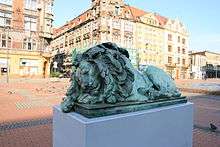
Bytom was one of the main centers of Polish resistance against Germanization in Upper Silesia in the 19th century, up until the mid-20th century. Polish social, political and cultural organizations were formed and operated here. From 1848, the newspaper Dziennik Górnośląski was published here. In 1895, the "Sokół" Polish Gymnastic Society was established, and, during the Silesian uprisings, in 1919–1920, Polish football clubs Poniatowski Szombierki and Polonia Bytom were founded, which later on, in post-World War II Poland both won the national championship. In the interwar period, Bytom was one of two cities (alongside Kwidzyn) in Germany, in which a Polish gymnasium was allowed to operate. In 1923 a branch of the Union of Poles in Germany was established in Bytom. Before 1939, the town, along with Gleiwitz (now Gliwice), was at the southeastern tip of German Silesia.
The Bytom Synagogue was burned down by Nazi German SS and SA troopers during the Kristallnacht on 9–10 November 1938. During World War II, the Beuthen Jewish community was liquidated via the first ever Holocaust transport to be exterminated at Auschwitz-Birkenau.[4][5][6]
In 1945 the city was transferred to Poland as a result of the Potsdam Conference. Its German population was largely expelled by the Soviet Army and replaced by a Polish population, some of them repatriated Poles from the eastern provinces annexed by the Soviets. Some of the indigenous Silesian population remained.
In 2017, the Tarnowskie Góry Lead-Silver-Zinc Mine and its Underground Water Management System, located mostly in the neighboring city of Tarnowskie Góry, but also partly in Bytom, was included on the UNESCO World Heritage List.[7]
Economy

Trade is one of the main pillars of the economy of Bytom. Being a city with long traditions of commercial trade, Bytom is fulfilling its new postindustrial role. In the centre of Bytom, and mainly around Station Street and the Market Square, is the largest concentration of registered merchants in the county.
In 2007, Bytom and its neighbours created the Upper Silesian Metropolitan Union, the largest urban centre in Poland.
Public transport
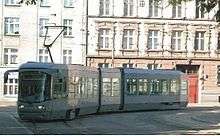
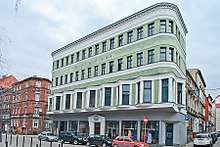
The tram routes are operated by Silesian Interurbans Tramwaje Śląskie S.A
Sport
Bytom is home to Polonia Bytom which has both a football and an ice hockey team (TMH Polonia Bytom). Its football team played in the Ekstraklasa most recently from 2007 to 2011, winning it twice in 1954 and in 1962. The Szombierki district is home to another former Polish champion Szombierki Bytom which won the title in 1980, and is one of the oldest clubs in the region.
Culture
Bytom's cultural venues include:
- Silesian Opera – ul. Moniuszki 21/23
- Miejska Biblioteka Publiczna w Bytomiu[8] (Town's Public Library)
- Dance Theatre Rozbark in Bytom
- Bytomskie Centrum Kultury[9] (Bytom Cultural Centre)
- Kronika – Center of modern art
- City Choir of St. Grzegorz Wielki
Among Bytom's art galleries are: Galeria Sztuki Użytkowej Stalowe Anioły, Galeria "Rotunda" MBP, Galeria "Suplement", Galeria "Pod Czaplą", Galeria "Platforma", Galeria "Pod Szrtychem", Galeria Sztuki "Od Nowa 2", Galeria SPAP "Plastyka" – Galeria "Kolor", Galeria "Stowarzyszenia.Rewolucja.Art.Pl", and Galeria-herbaciarnia "Fanaberia".
Festivals
- Annual International Contemporary Dance Conference and Performance Festival
- Theatromania – Theatre Festival
- Bytom Literary Autumn
- Festival of New Music
Education
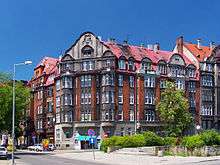
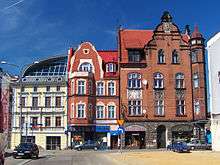
- The list of Bytom universities includes:
- Silesian University of Technology – Faculty of Transport
- Medical University of Silesia
- Polish Japanese Institute of Information Technology
- Wyższa Szkoła Ekonomii i Administracji
- Secondary schools:
- I Liceum Ogólnokształcące im. Jana Smolenia
- II Liceum Ogólnokształcące im. Stefana Żeromskiego
- IV Liceum Ogólnokształcące im. Bolesława Chrobrego
- 21 other secondary schools
Confederation of Silesia
Bytom is a place from where Confederation of Silesia – Polish Bonapartists originates.
Politics
Bytom/Gliwice/Zabrze constituency
Members of 2001–2005 Parliament (Sejm) elected from Bytom/Gliwice/Zabrze constituency
Notable people
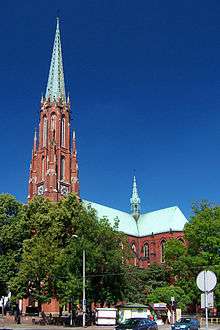

- Grzegorz Gerwazy Gorczycki (c. 1665–1734), Polish composer and musician
- Heinrich Schulz-Beuthen (1838–1915), German composer
- Siegfried Karfunkelstein (1848–1870), Prussian soldier
- Ernst Gaupp (1865–1916), German anatomist
- Ludwig Halberstädter (1876–1949), radiologist
- Adolf Kober (1879–1958), rabbi and historian
- Maximilian Kaller (1880–1947), bishop of Warmia
- Kate Steinitz (1889–1975), German-American artist and art historian
- Hartwig von Ludwiger (1895–1947), German general
- Max Tau (1897–1976), Jewish-German-Norwegian writer, editor and publisher
- Henry J. Leir (1900–1998), American industrialist, financier, and philanthropist
- Friedrich Domin (1902–1961), German film actor
- Herbert Büchs (1913–1996), German General
- Józef Kachel (1913–1983), head of the pre-war Polish Scouting Association in Germany
- Hans-Joachim Pancherz (1914–2008), German aviator and test pilot
- Horst Winter (1914–2001), German-Austrian jazz musician
- Leo Scheffczyk (1920–2005), German theologian and cardinal
- Haim Yavin (born 1932), Israeli news anchor
- Wolfgang Reichmann (1932–1991), German actor
- Reinhard Opitz (1934–1986), German political scientist
- Józef Szmidt (born 1935), Polish triple jumper
- Jan Liberda (1936–2020), Polish footballer
- Wiesław Ochman (born 1937), Polish opera singer
- Jan Banaś (born 1943), Polish footballer
- Walter Winkler (1943–2014), Polish footballer
- Zygmunt Anczok (born 1946), Polish footballer
- Jerzy Konikowski (born 1947), chess player
- Leszek Engelking (born 1955), Polish poet, writer, translator and scholar
- Waldemar Legień (born 1963), Polish judoka, Olympic champion from Seoul and Barcelona
- Marzena Godecki (born 1978), Australian actress
- Dorota Kobiela (born 1978), Polish filmmaker
- Paul Freier (born 1979), German footballer
- Jakub Pszoniak (born 1980), Polish writer[10]
- Gosia Andrzejewicz (born 1984), Polish pop singer
- Martyna Majok (born 1985), Polish-American playwright
- Kamil Drozd (born 1997), Polish musician
Twin towns – sister cities
References
- "Local Data Bank". Statistics Poland. Retrieved June 27, 2020. Data for territorial unit 2462000.
- J. Kramer, Chronik der Stadt Beuthen in Ober-Schlesien, Bytom, 1863, p. 1
- Roman Majorczyk, Historia górnictwa kruszcowego w rejonie Bytomia, Bytom, 1985, p. 9
- Jews deported from Beuthen (Bytom), list prepared in 1942 Archived 15 July 2009 at the Wayback Machine
- Elsa Drezner, Yizkor Book Project Manager Avraham Groll, Names of Jews deported from Beuthen Archived 26 July 2011 at the Wayback Machine
- Translations: deportation Archived 26 July 2011 at the Wayback Machine
- "Tarnowskie Góry Lead-Silver-Zinc Mine and its Underground Water Management System". UNESCO. Retrieved September 29, 2019.
- http://www.biblioteka.bytom.pl
- DESIGN, ARF. "Bytomskie Centrum Kultury". www.becek.pl.
- https://www.biuroliterackie.pl/biblioteka/utwory/szkody-gornicze/
- "Miasta partnerskie". bytom.pl (in Polish). Bytom. Retrieved March 10, 2020.
External links
| Wikivoyage has a travel guide for Bytom. |
| Wikimedia Commons has media related to Bytom. |
